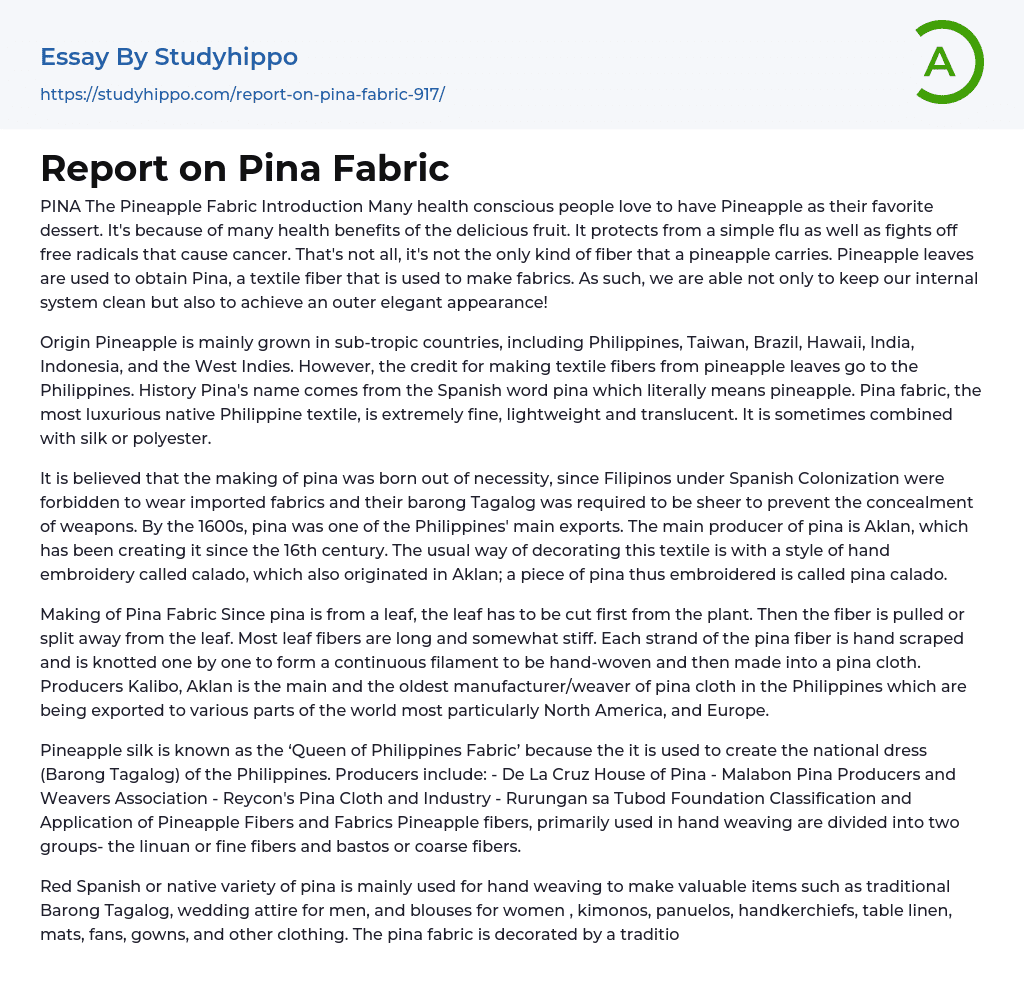PINA The Pineapple Fabric Introduction Many health conscious people love to have Pineapple as their favorite dessert. It's because of many health benefits of the delicious fruit. It protects from a simple flu as well as fights off free radicals that cause cancer. That's not all, it's not the only kind of fiber that a pineapple carries. Pineapple leaves are used to obtain Pina, a textile fiber that is used to make fabrics. As such, we are able not only to keep our internal system clean but also to achieve an outer elegant appearance!
Origin Pineapple is mainly grown in sub-tropic countries, including Philippines, Taiwan, Brazil, Hawaii, India, Indonesia, and the West Indies. However, the credit for making textile fibers from pineapple leaves go to the Philippines. History Pina's name comes from the Spanish word pina which literally means pineapple. Pina fab
...ric, the most luxurious native Philippine textile, is extremely fine, lightweight and translucent. It is sometimes combined with silk or polyester.
It is believed that the making of pina was born out of necessity, since Filipinos under Spanish Colonization were forbidden to wear imported fabrics and their barong Tagalog was required to be sheer to prevent the concealment of weapons. By the 1600s, pina was one of the Philippines' main exports. The main producer of pina is Aklan, which has been creating it since the 16th century. The usual way of decorating this textile is with a style of hand embroidery called calado, which also originated in Aklan; a piece of pina thus embroidered is called pina calado.
Making of Pina Fabric Since pina is from a leaf, the leaf has to be cut first from the plant. Then the fiber is pulled or split away from the leaf. Mos
leaf fibers are long and somewhat stiff. Each strand of the pina fiber is hand scraped and is knotted one by one to form a continuous filament to be hand-woven and then made into a pina cloth. Producers Kalibo, Aklan is the main and the oldest manufacturer/weaver of pina cloth in the Philippines which are being exported to various parts of the world most particularly North America, and Europe.
Pineapple silk is known as the ‘Queen of Philippines Fabric’ because the it is used to create the national dress (Barong Tagalog) of the Philippines. Producers include: - De La Cruz House of Pina - Malabon Pina Producers and Weavers Association - Reycon's Pina Cloth and Industry - Rurungan sa Tubod Foundation Classification and Application of Pineapple Fibers and Fabrics Pineapple fibers, primarily used in hand weaving are divided into two groups- the linuan or fine fibers and bastos or coarse fibers.
Red Spanish or native variety of pina is mainly used for hand weaving to make valuable items such as traditional Barong Tagalog, wedding attire for men, and blouses for women , kimonos, panuelos, handkerchiefs, table linen, mats, fans, gowns, and other clothing. The pina fabric is decorated by a traditional style of hand embroidery called calado. An embroidered pina garment is known as pina calado. When woven with silk, it is known as pina seda or pina-silk. PINA FASHION
- Accounting essays
- Marketing essays
- Automation essays
- Business Cycle essays
- Business Model essays
- Business Operations essays
- Business Software essays
- Corporate Social Responsibility essays
- Infrastructure essays
- Logistics essays
- Manufacturing essays
- Multinational Corporation essays
- Richard Branson essays
- Small Business essays
- Cooperative essays
- Family Business essays
- Human Resource Management essays
- Sales essays
- Market essays
- Online Shopping essays
- Selling essays
- Strategy essays
- Management essays
- Franchising essays
- Quality Assurance essays
- Business Intelligence essays
- Corporation essays
- Stock essays
- Shopping Mall essays
- Harvard Business School essays
- Harvard university essays
- Trade Union essays
- Cooperation essays
- News Media essays
- Waste essays
- Andrew Carnegie essays
- Inventory essays
- Customer Relationship Management essays
- Structure essays
- Starting a Business essays
- Accounts Receivable essays
- Auditor's Report essays
- Balance Sheet essays
- Costs essays
- Financial Audit essays
- International Financial Reporting Standards essays
- Tax essays
- Accountability essays
- Cash essays
- Principal essays




